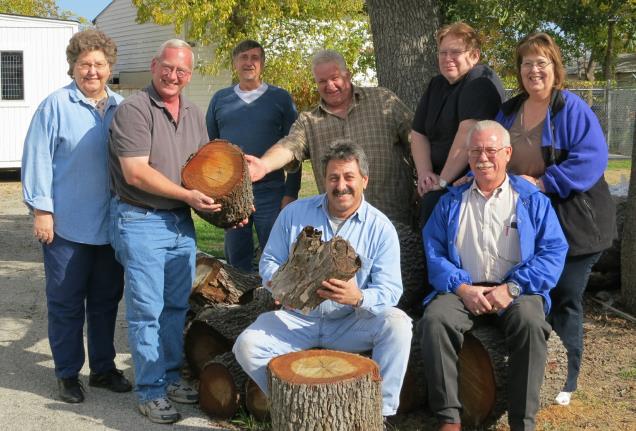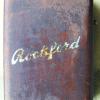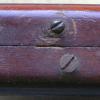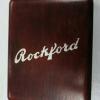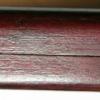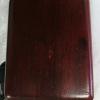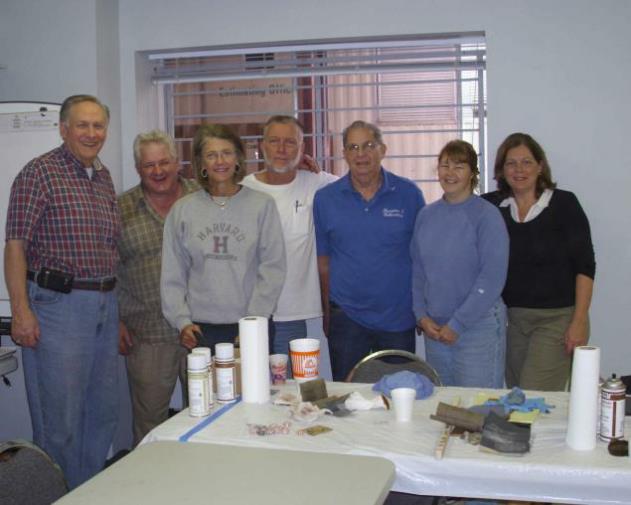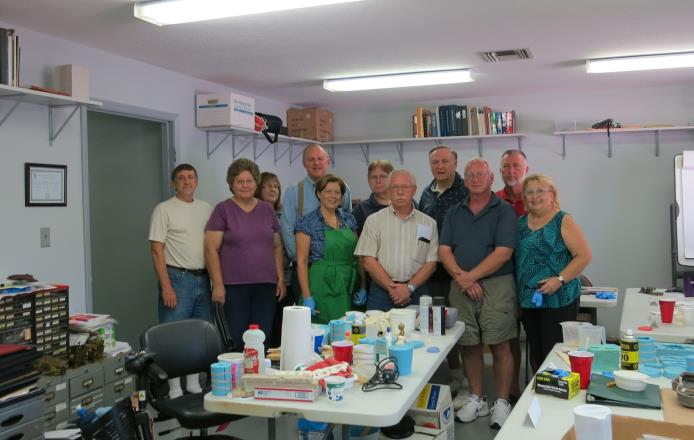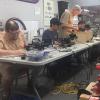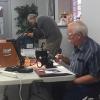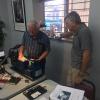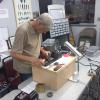Chapter 139 First Wood Case Restoration Class
Case for a 16 size pocket watch. More or less complete. John reminded me about getting a smoother surface when using a razor blade instead of sand paper or chemicals on the filled in areas. So, will redo a couple of areas. Any student taking this class should photograph the project before it is refinished as the pictures can be used for reference and presentations.
Some pictures from the first San Jacinto Chapter 139 case restoration class. Most cases are wood clock and watch cases. John Schmeig is willing to work with other case materials as well.
Below are some photos of the second Case Restoration Class. Refer to photos for comments.
= = = = = = = = = = = = = = = = = = = = = = = = =
Chapter 139 Second Wood Case Restoration Class
Chapter 139 French Clock Class
Fred Tishler gave several members (Joe Mixon, George Kabacinski, Roy Bryant, Tim Glanzman, Gordin Shahin, John Trego and Robert McGee) of Chapter 139 some great lessons in French Clock movements. Here are some random shots I took during the early stages of the class. They were so interested that they were not even going for the pastries.
The second group of photos were supplied by John Trego and Joe Mixon
7/14/2012
Chapter Mold And Casting Class
7//2012
Copyright 2010 NAWCC San Jacinto Chapter 139
Chapter Reverse Glass Painting Class
9//2012
On Saturday, Phil began the class by explaining the different types of images on the tablets of clocks and the history. He then explained the process of the technique that we were going to do in this class. We learned how to cut glass to size. We then applied the transfer to our piece of glass and let them sit overnight to dry. We also watched part of a video of Lee Davis giving a speech on the different techniques of Reverse Painting. Phil then demonstrated how to start painting the transfer. It is very important to start with the smallest, finest details first. He also explained how to pick the colors for the reverse paintings and what colors that were commonly used. On Sunday the fun began! We first started off by taking the transfers we had prepared and began removing the paper backing. This is a very tedious and fragile process, but once you get the hang of it, It goes really fast! Then we started to paint the transfers that Phil had brought. It is amazing how the colors transform from the back to the front, also amazing is how different the front & back of the painting look. Everyone in the class had a good time and we then wished Phil a Happy Birthday ! Hopefully now everyone that took this class will appreciate all the work that goes into a reverse painting! (by Nita Mixon)
= = = = = = = = = = = = = = = = = = = = = = = = =
= = = = = = = = = = = = = = = = = = = = = = = = =
= = = = = = = = = = = = = = = = = = = = = = = = =
Ann Jurecka, George Kabacinski, Phil Graham (instructor), Becky Bush, Joe Mixon, Tim Glanzman, Nita Mixon and Jim Eggert.
2016 June Pocket Watch Class
Class was held June 4 -5 and had full capacity of seven students (Bob Holkin, Edward McDowell, Gordon Shahin, Dennis Carroll, Izak Grinbaum, Gregory Graham and Tim Glanzman) all of whom successfully ended up with a running watch The main topic was to initiate students on complete disassembly, detailed part identification and reassembly with discussion and demonstration of watch tools and usage. Click on the link at the bottom if you would like to read an article on the class.
2016 November Pocket Watch Class
On the weekend of 29-30 October, the second of the “Basic Pocket Watch Servicing” classes was held with a full class of six students (Stanley Pryor, Drew Lundgren, Frank Thayer, Gregory Graham, Wayne Denham and Joe Mixon) in attendance. After coffee and kolaches, the class commenced with a short video explaining pocket watch operation followed by an exercise in grade and model identification. The students were then lead through proper care and sharpening of screwdrivers and tweezers before testing their skills on a dexterity exercise. The class quickly moved on to removal of the movement from the case followed by commencement of the disassembly process. There was only one minor casualty during disassembly (loss of a minute wheel) and despite best efforts to locate the errant part on the floor, it was unable to be found. Fortunately, a spare was readily available and work could proceed uninhibited. Once disassembly was complete, the class moved on to a component identification exercise and inspection of the components for wear and damage. The instructors then lead a brief discussion on cleaning processes and cleanliness during reassembly. The first day concluded with a practical exercise of mainspring removal, inspection/lubrications and reassembly. Starting bright and early on the second day, the students were eager to continue with the reassembly. Check processes during reassembly identified a few (normal) issues which were scrutinized and fixed. Lubrication was completed and balances reinstalled, with all students successfully ending up with a running watch. Basic regulation on a timing machine was completed before the movements were re-cased and the hands installed. (Shaun Clarke)
2017 January Spring Barrel Class
This past weekend (Jan 7-8) Chapter 139 held a spring barrel repair class at Turn Key Coatings for four students. The class diagnosed problems that the instructors had installed in several movements. The class then discussed and compared the count wheel strike against the basic rack & snail movement, removed cleaned and replaced springs from a barrel, replaced teeth in a barrel, put a new spring hook in a barrel, put a new hole in a spring for the hook and rebushed a barrel. The class went very well Saturday until the Texans football game came on. That's when all interest went out the window. Sunday again was going smoothly until Giovanni served up his homemade pasta and meat sauce along with fruitcake and fresh pecan tarts. The class simply adjourned as it had completed its tasks anyway. Participants were Joe Mixon, Wayne Denham, Tim Glanzman, Brent Flanakin, Giovanni Santarsiere, Bob Holkan, Drew Lundren and Marcus Bush. (Marcus Bush)
2016-17 Skeleton Clock Class
Last year a skeleton clock class lead by Del Rolison and Marcus Bush was initiated where students constructed their own skeleton clock. Pre manufactured components were used with the exception of the clock plates and a few other items. This course enabled the student to hone his skills in layout and brass work and well as metal polishing. The class was conducted over several sessions as most work had to be completed outside of the classroom. Several students took advantage of using the Tech Session day to complete items under supervision.
This was the third class on the introduction to pocket watches in which students were taught how to disassemble and assemble a 16 size open face pocket watch. This included the removal of cap jewels and main spring from the main spring barrel since these are critical functions when properly cleaning a movement. Parts cleaning was discussed but not performed due to time constraints. A standard watch movement was used (Elgin 7 jewel grade 291) so that everyone would be 'on the same page' throughout the course and since this particular movement is readily available for parts replacement in the event that any damage might occur during the process. I am happy to say that Shaun only had to dig into his Elgin parts box once or twice primarily due to parts becoming air born during the assembly process. I was surprised that several had problems installing the main spring arbor into the coiled end of the main spring. So far, each class has had difficulty with completely different tasks. I brought a large 5 pound magnet just in case this happened but, so far, have found everything by just crawling on the floor and looking. It is good that some of the attendees have good eye sight. The students did just great despite the fact that they had to work on tables (oh my back) instead of watchmaker's benches. However, most used the available instructor work bench when dealing with the more difficult and tedious tasks. No one complained.
The first day of this class was conducted at the same time as our usual monthly second Saturday Tech Session so attencdees missed out on a super presentation of watchmaker lathes by Tim Glanzman. On the second and last day of class Tim came in and visited with us. During our conversation with him we asked if he would repeat his presentation on lathes for the class as it was right on topic when we discussed watch tools. He graciously accepted our request and gave a repeat performance that was just SUPER! Thank you Tim.
March 2017 Pocket Watch Servicing Class attendees include (from l to r) Jack Barlow, Greg Stevens, Bob Turk, Shaun Clarke (instructor), Ike Grinbaum, Chris McDonald and Darrah Artzner (instructor).
2017 Introductory Pocket Watch Class
2017 4th Introductory Pocket Watch Class
2018 Full Plate (Intermediate) Pocket Watch Class
An enthusiastic group of students and instructors gathered for the fourth installment of the popular “Basic Pocket Watch Servicing” class on 28/29 October. This class had seven students participating, including several non-members who were excited to learn more about the art of watchmaking. One of the students had visited our booth at the Makers Faire the previous week and we were able to accommodate their request to join this class. President Tim Glanzman was on-hand to welcome the students and provide information about upcoming Chapter activities including the One-Day shows and Technical Sessions. Many of the students had no experience with watches but after the class introduction and some theory, all were eager to start the practical aspects of the class. Darrah Artzner introduced the students to the various tools used by watchmakers and discussed techniques for screwdriver and tweezer maintenance. The class then quickly moved on to the disassembly process and by early afternoon, all students had their watches completely stripped. Geoff Parker then led the class through servicing the mainspring and students had the opportunity to practice using mainspring winders to complete the mainspring barrel reassembly.
On Sunday morning, the students were keen to commence reassembly of their watches. Shaun Clarke demonstrated the assembly process, and then the students put into practice what they had seen under the watchful eye of the instructors. Reinstalling the balance proved a little challenging but with some assistance, everyone was successfully able to complete this. All seven movements were successfully running again by early afternoon and Darrah was on hand to ensure they were in fine fettle. The students were then given a brief introduction to the timing machine before completing reassembly and re-casing their watches.
Several of the students brought watches to the class to share with the participants. These included a very nice Illinois Bunn Special, a Hamilton 940 and an Elgin 571 and an Elgin BWR. Some of the watches had issues and we look forward to assisting students work on these at future Technical Sessions.
Our thanks to Tim (and his employees) for the use of cafeteria space, and to the instructors for sharing their experience and time. This class continues to grow as an entry point for those getting started on watches, so please reach out to friends inside and outside the club who may be interested in the next class.
Shaun Clarke
Participants include: Steve Egloff, Roy Bryant, Mary Forsyth, Greg Henson, Tio Fallen, Genevieve Erdbruegger and Michael Dewlen. Instructors: Shaun Clarke, Geoff Parker and Darrah Atzner.
Over Memorial Day weekend, the intermediate “Full-Plate Pocket Watch Servicing” class was held at Turn-Key Coatings. The class, led by instructors Shaun Clarke, Darrah Artzner and Geoff Parker, focused on the cleaning and lubrication of American Waltham 1883 full-plate movements. There was good support for the class and students Wayne Denham, Gregory Graham, Gordon Shahin and Tim Glanzman were eager to expand their watchmaking knowledge. After a brief introduction on movement identification, students commenced with disassembly and inspection of the movements that were supplied by the Chapter. The class was split into two groups with Tim and Gregory completing mechanical and ultrasonic cleaning under the watchful eye of Darrah while Shaun and Geoff led Wayne and Gordon through mainspring servicing. Once complete the groups then swapped activities.
Given this was the first time the class was offered, it soon became apparent that we would need more than one day to complete assembly and the decision was made to continue work on Sunday.
The second day focused on assembly and oiling activities with good discussion on choice of lubricants and proper oiling techniques. Despite the best efforts by all students, there were some challenges on getting all the movements running as some components needed additional repairs and/or replacement that were beyond the scope of the class. Despite these setbacks, the students increased their skills and experience in serving pocket watches and all participants indicated enjoyment of the class.
As always, thanks to Tim for the use of his facilities and to our members for their interest and participation.
(Editor's comment: Movements used for class were purchased from eBay and it was decided not to clean or inspect any movements internally prior to class other than make sure they 'appeared to run'. As a result, problems were revealed during the class that gave one the impression they were a result of 'swapping' out with other movements to be cased.)
Shaun Clarke
2019 Introductory Micro-Lathe Class
A good time was had by all—I should know, as I was one of the students.
Chapter 139 held an “Introduction to the Lathe” class the last weekend in May, 2019. With five students and three instructors you know that there’d be plenty of expertise imparted.
Taught by Drew Lundgren, Desmond Rolf, and Del Rolison the initial exercises were deceptively simple: turn a short piece of aluminum rod to differing diameters and lengths as shown on a schematic. Do it again, but with brass. And, finally, a third time, but with steel.
One of the diameters was particularly small—requiring a sharp cutter, patience, and a modicum of finesse so as not to ruin the work as one removed material and the work piece deformed as it was cut. Simultaneous we learned the tactile and cutting differences in the three materials as we worked to match the exacting dimensions required.
A subsequent exercise included cutting threads (tap & die) in two pieces and getting them to mate without lip or overhang. A final exercise for those that finished early: make an arbor to match a designated set of pivot holes in two plates. Don’t forget end-shake!
After the clever exercises of the first day students were introduced not to the limitations of the materials they were working, but the limitations of their lathes! Presented with a schematic, a bit of brass rod, and long bit of aluminum rod we proceeded to make small hammers (one end with Delrin) that we could show off and use in future projects. In my humble opinion this “Introductory” class had suddenly jumped to “Intermediate” if not the big leagues. We all struggled as the long aluminum shafts of our hammers defeated the short beds of our Sherline lathes with tail stocks hanging precariously over empty space—not enough room for dead centers, let alone live ones! Except for Joe. Joe with the extra-long lathe bed smiled as the rest of us struggled.
Edward McDowell
Students included: Joe Mixon, Frank Thayer, Edward McDowell, Theo McDowell, and Clyde Crouch.
